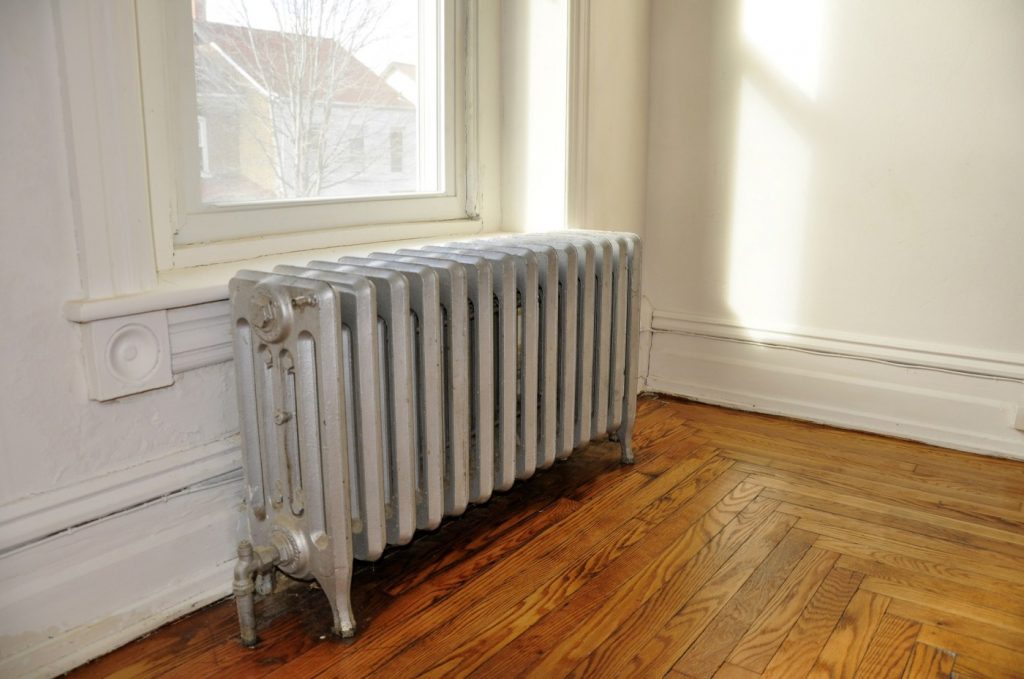Lily Meier | Bloomberg News (TNS)
Open the door to an apartment at 2 Charlton Street, and the space will look like any of the 3.6 million units in New York.
That is, with one notable exception: The windows are likely to be closed in the winter, a rarity in older New York buildings where the heat is often blasting from radiators. And yet the unit will be a Goldilocks temperature, just right.
The secret to 2 Charlton’s comfort is an easy-to-miss white box tucked into the corner, what New York-based technology startup Kelvin calls “the Cozy.” It’s a smart radiator that can cut greenhouse gas emissions and costs — and most importantly to residents, improve comfort. In a world where old buildings pose a stubborn decarbonization challenge, Kelvin is aiming to make it easier to cut emissions now and build a bridge to electrified heating and cooling.
Radiators work by pumping steam through pipes. Around 80% of buildings in New York rely on steam heating, which replaced stoves and fireplaces in the early 20th century, according to the nonprofit Urban Green Council. While that helped cut harmful air pollution then, it’s an inefficient form of heating today.
The traditional New Yorker solution to a too-hot radiator is letting the outside chill in in hopes of equalizing the temperature. While opening a window may relieve sauna-like conditions, it means the gas boilers powering radiators are working overtime, ramping up emissions and expenses. Inefficient operations contribute to building emissions, which are more than two-thirds of the city’s carbon footprint. And they lead to around $2 billion wasted on gas annually in New York, according to Kelvin.
“The New York story is you live in a tiny, overheated apartment,” said Marshall Cox, Kelvin’s chief executive officer and founder. He developed the Cozy as a solution to make steam heating in older buildings more efficient.
Cox experienced the discomfort of New York apartments firsthand when he was an engineering student at Columbia. That led him to build the first Cozy for his “horrible” apartment and launch Kelvin — formerly known as Radiator Labs — in 2013.
The Cozy fits over a radiator and traps steam heat behind the cover. It then uses sensors to release heat based on the temperature of the room as well as the radiator. When the room needs heat, the fan within the Cozy circulates hot air through the room. The trapped steam can also be sent to other parts of the building that may need heat. (While an individual apartment can install a Cozy, the startup currently only does complete building retrofits to maximize efficiency.) Kelvin was named a BloombergNEF Pioneer this year for its innovative approach to building decarbonization.
It takes Kelvin between one and six months to complete a project, including manufacturing, shipping and installation, and the company has put the Cozy system in residential buildings as well as schools, theaters and dorms. The radiator cover, which residents can use to set their apartment’s temperature, also collects data that can help determine when a building’s boiler should be operating. Kelvin has sold 30,000 Cozys, half of which have been installed. The introduction of utility and tax rebates as well as greenhouse gas regulations over the past several years have sent sales “through the roof,” Cox said.
The Cozy saves an average of more than 25% on heating costs in buildings utilizing steam radiators, according to Kelvin. And it also can provide residents with much-needed comfort. Chris McGinnis, a now-retired former systems engineer at IBM and co-op board member of 2 Charlton Street, brought the Cozy to his building in 2021, after piloting it. He has lived in the building since 1990 and first lived on the building’s second floor. That apartment was so hot that he would have to turn on the air conditioning in the winter.
It was “just so stupid,” recalled McGinnis, who found out about Kelvin in 2013. “You have this gigantic building and everyone has their windows open because they’re smoking hot.”
He didn’t have trouble convincing his co-op board to try out the innovation. “When they realized this could cost very little, save money and make them more comfortable, it wasn’t a big push,” McGinnis said.
Related Articles
How the promise of big energy savings in one Bay Area school district led to a $50 million controversy
US officials warn cyberattacks on water systems are increasing
Monterey Bay Aquarium to offer free admission to low-income residents
Researchers follow orca ‘flukeprints’ in Monterey Bay
How one Safeway controversy kicked off the spread of gas station bans around the Bay Area
The building has earned back what it spent on its Cozys, having saved $37,662 in fuel costs and 168.2 tons of carbon emissions. More than 60% of the 175 units in 2 Charlton now have Kelvin’s system. While the vast majority of the Cozy installations have been successful, a couple of McGinnis’ neighbors got rid of theirs because of concerns about the product’s digital connectedness and incorrect use of the technology.
“It’s New York City, life isn’t exactly perfect, but this is a major step in the right direction,” McGinnis said on the Cozy.
Most of the “pushback” Kelvin has gotten is related to financials, Cox said, adding that “people don’t want to spend money unless they absolutely have to.” Replacing radiator heating systems with a fully electric system can be even more costly, though, which is why Cox still sees a wide lane for Kelvin.
“I do not view full electrification as competition at all,” he said, sharing his doubt about its prospects. “It’s so expensive, it will never happen.”
Cozys can either be paid for all at once or using Kelvin’s no-money-down payment plan. If paid for when purchased, the Cozy costs $850 per apartment, including installation. The no-money-down option allows apartments to pay off the purchase in $10 to $20 monthly installments over the course of 10 to 15 years.
Further lowering costs, the cover qualifies for incentives in the Biden administration’s Inflation Reduction Act. Federal and state incentives cover between 50% and 70% of the Cozy’s cost, making the price tag of each radiator cover around $200.
With Kelvin’s system, 2 Charlton is compliant with New York’s Local Law 97, a piece of legislation passed to limit greenhouse gas emissions from larger buildings with a goal of cutting them 40% by 2030.
“All of a sudden, it’s made every single landlord in New York City invested in reducing emissions in their buildings,” Rewiring America’s Director of Research Cora Wyent said of the legislation.
Policies like Local Law 97 may also lead to the creation of more startups like Kelvin offering building decarbonization options, according to Wyent. While radiator covers can cut emissions in the near term, cutting them further will require ending the use of fossil fuels for heating.
Heat pumps can do that, decarbonizing both heating and cooling. Some startups and incumbent HVAC companies, notably Gradient and Midea, have pioneered window heat pumps that can be installed in apartments.
Kelvin is in the modeling and prototyping stage of what it calls a hybrid electrification system, which pairs heat pumps and thermal batteries with its radiator enclosures. The company expects the system to be commercially ready by 2025. The startup expects its upcoming system to cost less than a fully electrified heating and cooling system, which can run from $11,400 per unit and up in New York, according to an Urban Green Council estimate. Through its approach, Kelvin can electrify 80% of a building for 10% of the cost, according to the company.
With assistance from Marie Monteleone.
©2024 Bloomberg L.P. Visit bloomberg.com. Distributed by Tribune Content Agency, LLC.


